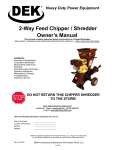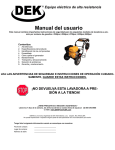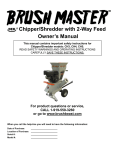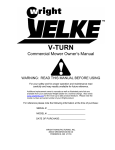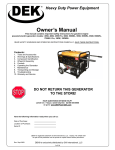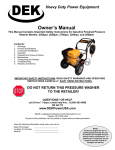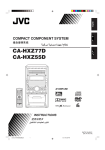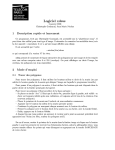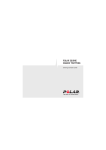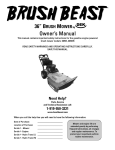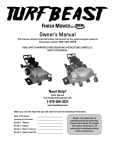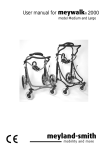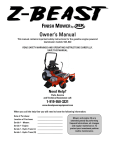Download DEK 36BX Owner`s manual
Transcript
® Heavy Duty Power Equipment Owner’s Manual This manual contains important safety instructions for the gasoline engine powered lawnmower models: 36B, 36BX, 36H, 36HX, 52H, 52HX READ SAFETY WARNINGS AND OPERATING INSTRUCTIONS CAREFULLY. SAVE THIS MANUAL. DO NOT RETURN THIS LAWN MOWER TO THE STORE! HAVE QUESTIONS OR NEED HELP? call 24 hrs / 7-days a week help-line: [1] 800-393-0668 or go to www.DEKPowerUSA.com Have the following information ready when you call us: Date of Purchase: Location of Purchase: Serial # - Mower: Serial # - Engine: Serial # - Transmission _______________________ _______________________ _______________________ _______________________ _______________________ NOTE: Mower and engine life are extended greatly through the use of frequent lubrications, oil changes and providing routine maintenance. To protect your investment, do not forget to perform routine maintenance. DEK® is registered trademark of GXi International, LLC Clayton, NC 27520 USA No part of this publication can be printed or copied without written permission. ® Heavy Duty Power Equipment See our website at www.DEKPowerUSA.com or contact us at 919-550-3221 for more details on our full line of DEK Heavy Duty Power Equipment product as shown below: Generators, Welder Generators & Accessories A complete range of gasoline generators from 4 kW of continuous power, to 7.5 kW models. They are ideal for a wide range of applications from recreational usage to commercial duty emergency power and construction site power. Accessories include generator kits, generator covers, heavy duty extension cords & twist lock adaptors. Pressure Washers & Accessories 2650 PSI axial pressure washer and 2700 PSI, 3200 PSI, 3600 PSI, 4000 PSI pressure washers that utilize a proprietary triplex, commercial grade pump design that is rated to exceed 500 hours of usage. The pressure washers include industry leading corrosion resistance, Never-go-Flat tires, a folding frame design for compact storage and many other innovations. Accessories include detergent concentrate, nozzles, quick connects, hoses and wands. Chipper Shredder Driven by a powerful 13 hp engine, this chipper is capable of devouring 3”x4” lumber without hesitation. Loaded with innovative features and designed for durability. No competing products are in the same class as this chipper shredder. Ideal for residential, commercial, and rental use. Comes complete with a trailer hitch for lawn and garden tractors or ATVs. Lawn Mowers & Accessories 36” and 52” commercial landscaper grade zero-radius lawn mowers, brush mowers, and tow behind mowers. Heavy duty decks, dual belt drive and hydro drive systems. Ideal for commercial and heavy duty residential applications. Key features include a quick height adjustment and a floating deck design. Accessories include a riding sulkies, mulching kits, and grass catchers. Heavy Duty Power Equipment About the DEK Belt Drive Lawn Mower Manual 36B, 36BX, 36H, 36HX, 52H, 52HX Congratulations on the purchase of your new DEK commercial mower. We at GXi International are confident that this mower will provide you with the best performance, outstanding quality, and great durability when operated and maintained as directed in this manual. 1. This manual contains assembly, operating, safety, adjustment, maintenance, and troubleshooting instructions. BEFORE OPERATING YOUR LAWN MOWER, CAREFULLY READ THIS MANUAL IN ITS ENTIRITY. 2. This owner’s manual is considered a permanent part of the mower. It must be available to all of the operators and/or person(s) servicing the mower. Should the mower be resold, this manual must remain with the mower. 3. All information, illustrations, and specifications contained in this manual were in effect at the time of the publication. GXi International reserves the right to add, delete or modify specifications and/or designs without notice. 4. If you ever have questions in regards to the operation, maintenance or safety of your mower, please contact the DEK technical service line at 1-800-393-0668. Table of Contents Safety Information Safety Warnings .………………………………………………………………...………………………………………….. 4 Before Use of Equipment …………………………………………………………………………………………………... 4 Operation of Equipment – Safety Cautions ………………………………..……………………………………………... 4 Safety Information Decals ………………………………………………………………………………………………….. 5 Operating the Mower Product Specifications……………………………………………………………………………………………………….. 5 Control Panel Component Identification…………………..…………...………………………………………………….. 6 Lawn Mower Component Identification...…………………………………………………………………………………...6 Assembly Instructions…………………………………………………………………………………………….7 through 11 Starting the Engine……………………………………………………………………………………………………….... 12 Moving Forward.……………………………………………………………………………………………………………… 12 Turning the Mower…………………………………………………………………………………………………………… 12 Stopping the Mower………………………………………………………………………………………………………….. 12 Moving in Reverse…………………………………………………………………………………………………………… 12 Mowing………………………………………………………………………………………………………………………... 13 Changing Cut Height..……………………………………………………………………………………………………….. 14 Removing Blades……………………………………………………………………………………………………………. 14 Service and Maintenance Maintenance Schedule………………………………………………………………………………………………...…… 15 Fuel……………………………………………………………………………………………………………………………. 15 Engine Oil…………………………………………………………………………………………………………………….. 15 Air Filter………………………………………………………………………………………………………………………. 15 Tire Pressure………………………………………………………………………………………………………………… 15 Blades………………………………………………………………………………………………………………………… 15 Cleaning the Mower…………………………………………………………………………………………………………. 15 Lubrication Points……………………………………………………………………………………………………………. 16 Adjustments Drive Belt Adjustments………………………………………………………………………………………………………. 17 Wheel Brake Adjustments…………………………………………………………………………………………………….17 Engine to Blade Belt…………………………………………………………………………………………………………. 17 Blade to Blade Belt………………………………………………………………………………………………………….. 17 Engine to Transmission Belt……………………………………………………………………………………………….. 18 Safety Interlock System…………………………………………………………………………………………………….. 18 Troubleshooting Guide…………………………………………………………………………………………………………….. 19 Warranty……………………………………………………………………………………………………………………………... 22 Rev: 8/2008 DEK® is exclusively distributed by GXi International, LLC 3 of 21 Heavy Duty Power Equipment Safety Information and Warnings This owner’s manual is considered a permanent part of the lawn mower and should remain with the lawn mower if resold. The information and specifications included in this publication were in effect at the time of approval for printing. GXi International, LLC, exclusive marketer of DEK Heavy Duty Power Equipment, reserves the right to discontinue or change specifications or design at any time without notice and without incurring any obligation whatsoever. No part of this publication may be reproduced without written permission. Mower Inspection For your safety, inspect the lawn mower before each use of operation. In order to inspect your lawn mower, the following conditions should be met: the lawn mower should be on a flat and level surface, with the ignition switch off, key removed, and blades disengaged. Also the spark plug wire should be off of the spark plug. 1. 2. EMISSION CONTROL SYSTEM INFORMATION The U.S. and California Clean Air Acts EPA and California regulations require all manufacturers to furnish written instructions describing the operation and maintenance of emission control systems. The following instructions and procedures must be followed in order to keep the emissions from your DEK engine within the emission standards. SAFETY LABEL LOCATIONS These labels warn you of potential hazards that can cause serious injury. Read them carefully. If a label comes off or becomes hard to read, contact your DEK lawn mower dealer for a replacement. SAFETY INFORMATION DEK lawn mowers are designed to give safe and dependable service if operated according to instructions. Read and understand this owner’s manual before operating your lawn mower. OPERATOR RESPONSIBILITY Know how to stop the lawn mower quickly in case of emergency. Understand the use of all lawn mower controls, output receptacles, and connections. Be sure that anyone who operates the lawn mower receives proper instruction. Do not let children operate the lawn mower without parental supervision. 3. 4. 5. 6. 7. Do not use your DEK lawn mower to carry passengers. When people, especially children, an pets are close by, avoid mowing since rotating blades can throw rocks and other items, which can cause serious injury. Before Using Your DEK Lawn Mower WARNING DANGER: GASOLINE IS HIGHLY FLAMMABLE AND EXPLOSIVE. Do not add fuel while the engine is running or is hot. Keep open flames, sparks, and heat away from the fuel and store fuel in containers specifically designed for that purpose. ADD FUEL OUTDOORS ONLY AND IF THE FUEL IS SPILLED, DO NOT START THE ENGINE. Manually push the mower away from the spill and wipe up immediately. 2) 3) 4) 5) 6) CAUTION When operating your DEK lawn mower, wear protective clothing while mowing. Long pants and safety glasses will help reduce the risk of injury from thrown objects. It is recommended that adequate footwear, such as steel toe shoes with aggressive soles, be worn to help protect your feet and maintain traction on slopes or uneven grounds. Always wear hearing protection. Inspecting Your Lawn Mowing Area Inspect the area where your DEK lawn mower will be used. Check for stones, sticks, wire, and other foreign objects. These objects may become projectiles that can cause serious injury and/or death when struck by the mower. 7) 8) 9) 10) 11) 12) 13) 14) Rev: 8/2008 Walk around the mower and look for any fluid spills or leaks on or underneath the mower. Remove any and all excessive debris, dirt, and/or fluids. Look for signs of damage or excessive wear. Check the tightness of all nuts, bolts, pins, and screws. Tighten any that may be loose and replace any that are missing. Be sure the safety interlock controls are operating properly so that the engine cannot be started unless the ground speed control lever is in neutral and the blades are disengaged. Check the mower blades for any damage or abnormal wear and replace in sets so that they are balanced. Check the tire pressure on all four tires. See page 15 for instructions Check the belts for proper wear and correct tension. See pages 17 and 18 for instructions. Check engine oil and air filters as recommended by the en- Operation of Equipment - Safety Cautions 1) WARNING 36B, 36BX, 36H, 36HX, 52H, 52HX Do not operate the engine in a confined space where dangerous carbon monoxide fumes can collect. Carbon monoxide is odorless, tasteless, and can be fatal. Mow only in daylight. Make sure the mower is in neutral and the blades are disengaged before attempting to start the engine. Do not stop or start suddenly when going uphill. Never use riding attachments on slopes since there is an increase risk that they might roll over. Avoid steeps slopes and use extreme caution when changing directions while operating on a slope. Be extremely careful when operating on a slope or when the grass is damp or wet. Reduced traction could cause sliding. Never mow by pulling the mower back towards you because you might slip. Watch for traffic when crossing surfaces other than grass (i.e. transporting) loading a trailer or vehicle, or when the mower is not in use. Never operate the mower with defective guards, shields, or without the safety devices securely mounted in place. Never direct discharge of material toward bystanders nor allow anyone near the mower during operation. Do not change the governor settings or over speed the engine. Always stop the engine whenever you leave the mower, even for a moment. To help reduce the risk of a fire hazard, keep the engine and the area around the engine free of grass, leaves or any other type of foreign material. Beware of cutting edges. Always wear gloves for safety when performing blade maintenance activities. Beware on multiple blade units since the rotation of one blade may cause the rotation of the other blade. Do not store or operate the mower with the grass chute deflector in the raised position. Serious injury could occur. DEK® is exclusively distributed by GXi International, LLC 4 of 21 Heavy Duty Power Equipment Safety Decals & Product Specifications 36B, 36BX, 36H, 36HX, 52H, 52HX IMPORTANT! The mower belts are adjusted to ensure the blades stop turning within 7 seconds of releasing the blade control lever. If you are making any belt adjustments whatsoever, for your safety and the safety of others around you, you must ensure the belts are re-adjusted to achieve this design specification. Safety Decal Identification The labels found below are located on your mower to warn you of potential hazards and provide you with important safety information. If these decals become difficult to read or are missing from the mower, please contact your DEK mower dealer for a replacement. Product Specifications Models Lawn Mower 36B 36BX 36H 36HX 52H 52HX Product Type Commercial, 0-turn Commercial, 0-turn Commercial, 0-turn Commercial, 0-turn Commercial, 0-turn Commercial, 0-turn Cutting Width 36” 36” 36” 36” 52” 52” 11hp Honda 13hp DEK 13hp Honda 14hp DEK 16hp Honda, v-twin 14hp DEK Engine Start Recoil Electric / Recoil Recoil Electric / Recoil Electric Electric Transmission Type Gear Gear Hydrostatic Hydrostatic Hydrostatic Hydrostatic Peerless Peerless Hydro-Gear Hydro-Gear Hydro-Gear Hydro-Gear 5 forward/1 reverse 5 forward/1 reverse Variable Variable Variable Variable Deck Type Floating, quick change Floating, quick change Floating, quick change Floating, quick change Floating, quick change Floating, quick change Cutting Height 1.5”- 4.5” ½” increments 1.5”- 4.5” ½” increments 1.5”- 4.5” ½” increments 1.5”- 4.5” ½” increments 1.5”- 4.5” ½” increments 1.5”- 4.5” ½” increments Blade Engagement Manual clutch Manual clutch Manual clutch Manual clutch Manual clutch Manual clutch Blade Tip Speed 18,750 ft/min 18,750 ft/min 18,750 ft/min 18,750 ft/min 18,750 ft/min 18,500 ft/min Anti-Scalping Rollers None None None None 3 front/2 rear 3 front/2 rear No. Blades/ Length 2/18” 2/18” 2/18” 2/18” 3/18” 3/18” Pistol Grip Pistol Grip EZ Lever EZ Lever EZ Lever EZ Lever Gasoline/4.5 gals. Gasoline/4.5 gals. Gasoline/4.5 gals. Gasoline/4.5 gals. Gasoline/4.5 gals. Gasoline/4.5 gals. 13” X 6.5” turf tread 9” X 3.5” smooth tread 13” X 6.5” turf tread 9” X 3.5” smooth tread 16” X 6.5” turf tread 9” X 3.5” smooth tread 16” X 6.5” turf tread 9” X 3.5” smooth tread 18” X 8.5” turf tread 9” X 3.5” smooth tread 18” X 8.5” turf tread 9” X 3.5” smooth tread Brake System 6” band brakes 6” band brakes Hydraulic service/ manual parking break Hydraulic service/ manual parking break Hydraulic service/ manual parking break Hydraulic service/ manual parking break Weight Approx. 450 lbs. Approx. 450 lbs. Approx. 450 lbs. Approx. 450 lbs. Approx. 510 lbs. Approx. 510 lbs. 45” x 72” 45” x 72” 45” x 72” 45” x 72” 45” x 72” 45” x 72” Engine Manufacturer Speeds Control System Fuel/Capacity Rear Drive Tires Front Caster Tires Height/Length Rev: 8/2008 DEK® is exclusively distributed by GXi International, LLC 5 of 21 Heavy Duty Power Equipment Control Panel and Lawn Mower Components 36B, 36BX, 36H, 36HX, 52H, 52HX Control Panel Identification Throughout this manual, instructions are given on the operation of your DEK mower. We recommend that while going through this manual, you have your mower available for quick and easy access in order to orient yourself with the controls, maintenance, and orientation of different parts. Please read through the manual before operating. Below, you will find a diagram of the control panel. Please take the time to familiarize yourself with the mower controls. Gear Drive Models Hydro Drive Models Blade Control Lever Brake Operator Presence Controls Throttle/Choke Control Key Switch Forward / reverse speed control Gear Shift Lever Lawn Mower Feature Identification (some features may appear different than shown, depending on the model) “Operator present” safety switches Blade control lever Fuel tank Hydro brake / lock (hydro models only) Pulley guard Control panel Handle bar height adjustment Muffler (HOT!) Height adjustment pins (4) Side discharge chute Scalping wheels Hydro Drive Models Hydro system by-pass release pins allow the wheels to spin freely (pull out and detent two pins for free wheeling). Rev: 8/2008 DEK® is exclusively distributed by GXi International, LLC 6 of 21 Heavy Duty Power Equipment 36B, 36BX, 36H, 36HX, 52H, 52HX Assembly Instructions Step 1: Front Wheel Assembly Note: some mowers may be shipped with the front wheels pre-assembled. A) Remove packaging materials surrounding the front wheels and remove the bolt threaded into the front wheel. Retain this bolt and washer for future use. B) Unscrew the fastener holding the bolt to the steel shipping rack. Set the nut and bolt aside. It will be re-used in the mower assembly process. C) Remove the mower from the steel shipping rack. D) Slide the front wheel pivot shaft through the sleeve. If the fit is tight, apply some grease to the pivot shaft. E) Secure the shaft in place with the bolt and hardware that were provided with the wheel. F) Repeat steps A through E for the second front wheel. G) Apply grease to the front wheel sleeve grease fittings when complete. Rev: 8/2008 DEK® is exclusively distributed by GXi International, LLC 7 of 21 Heavy Duty Power Equipment 36B, 36BX, 36H, 36HX, 52H, 52HX Assembly Instructions Step 2(a): Assembly Instructions for Mowers with Hydraulic Drive Systems (36H, 36HX, 52H, 52HX) 1) Attach handle bars using the upper hole position setting if you are walking behind the mower (not using a ride-on Sulky). By using this hole position, the handle bars are several inches lower. Use the lower hole position if you are planning on using a ride-along sulky, raising the handle bar location by several inches. These hole positions can also be used for adjusting the handle bar location for operators with different heights and arm lengths. Select the height that is most comfortable for you. 2) Reconnect the 4 connecting rods from the control panel to the chassis pivot points as per the attached pictures. The rod connections are secured with an initial preset for the upper hole position (lower handle bar position). If the lower hole position (upper handle bar position) is used the rod connections must be adjusted. 3) Retighten the pivot bolts on the triangular plates on each side of the gas tank support bracket (2 locations, one on each side of the mower). 4) Should the pivot ends on the connecting rods be rotated during assembly, minor adjustments may be required to achieve full travel on each control handle. The control handles located directly on top of the handle bars should have full travel forward and stop approximately 1/8” before the “V plate” strikes the handle bar. This will provide full forward speed and the correct restricted speed in reverse. Please make any minor adjustments to the position of the threaded connecting rod attachment Rev: 8/2008 1/8” gap in full forward position DEK® is exclusively distributed by GXi International, LLC 8 of 21 V-Plates Heavy Duty Power Equipment 36B, 36BX, 36H, 36HX, 52H, 52HX Assembly Instructions Step 2(b): Assembly Instructions for Mowers with Belt Drive System (36B, 36BX) 1) Attach the handle bars using 2 bolts on each side of the fuel tank bracket. Select the desired hole locations to adjust for the handle bar height. For lower handle bars, use the top hole location as shown in the diagram. For higher handle bars, use the lower hole location Hole location for higher handle bar positioning 2) Attach the clutch / brake control rods to the clutch brake assembly on each side of the mower. Adjust for desired level of sensitivity by turning the threaded lug on the rod. The adjustment may take a few attempts to achieve: equal balance between the two break handles so they feel the same; easy disengagement from the parking break detent built into the pistol grip handle; and full contact with the brake when the handle is retracted (see page 17 for more adjustment details). Threaded blade activation control rod. 3) Unfasten the blade activation rod from the control handle, insert it through the hole on the chassis of the mower, and attach the rod to the blade activation cam assembly as per the adjacent photo. Ensure the cam is positioned in the “9 O’ clock” position when attaching the rod to accomplish the correct rod travel. Once the rod is attached to the cam, re-attach the other rod end to the control handle again. For correct rod adjustment, you want to maintain the “9 O’ clock” position of the cam with the blade activation control knob in the full “off” position. Turn the threaded rod until it achieves the correct cam positioning. 9 O’ Clock cam position when connecting the rod with the control handle in the “off” position achieves the correct adjustment 4) Attach the gear shift lever by inserting it through the slot in the fuel tank bracket and attaching it to the gear shifter bolt on the transmission. Tighten the bolt securely. Feed the handle assembly through the slot from the engine side of the fuel tank bracket. Fuel tank bracket Gear shift lever Retaining nut attached to gear shift bolt Rev: 8/2008 DEK® is exclusively distributed by GXi International, LLC 9 of 21 Heavy Duty Power Equipment 36B, 36BX, 36H, 36HX, 52H, 52HX Assembly Instructions Step 3: Wire Harness Assembly and Connections For 52” Models There are a total of 4 connections to connect the pre-wired handle bar assembly. Route the wire harness as shown on the adjacent photo and make the following connections: 1. The smaller, white, 2-pin connector is routed through a hole in the chassis and is connected to the blade activation safety switch 2-pin connector. 2. The larger, white, 5-pin connector is connected to the mating connector at the rear of the Honda engine. 3. The black wire is connected to a ground lug located on the back of the Honda engine. 4. The yellow wire is attached to the bottom of the starter motor solenoid on the Honda engine. 1 3 In addition, the battery terminal wires must be connected to provide power to the electric starter. Attach the red and black battery terminal wires to the battery. Once all connections are made, the wire harness can be strapped into place permanently to the handle bars and chassis using the black wire-ties provided. 4 For 36” Models 2 The 36” models have the following connections: 1. The 36” hydro drive model has the same as “connection 1” for the 52” models discussed above, connecting the blade activation safety switch located underneath the front of the chassis. The wire harness is routed through a hole in the chassis as per the above diagrams. 2. For the belt drive 36” models, connect the blade activation safety switch located on the back of the chassis. It is a two pin connector coming from a black switch box under the fuel tank bracket. See adjacent photo. 36” belt drive blade activation safety switch location top view. 3. There are 2 engine connections from the wire harness. A black wire that is attached to a ground lug on the engine and a red wire connector that is attached to the red wire crimp connector located at the rear of the Honda engine. The crimp on connector is typically covered with a green plastic sleeve. The red wire is the engine kill switch wire. Once all connections are made, the wire harness can be strapped into place permanently to the handle bars and chassis using the black wire-ties provided. Rev: 8/2008 Black ground wire for Honda engine. Red wire with crimp connectors and typically a green plastic cover. DEK® is exclusively distributed by GXi International, LLC 10 of 21 Heavy Duty Power Equipment 36B, 36BX, 36H, 36HX, 52H, 52HX Assembly Instructions Throttle cable clamp Step 4: Throttle and Choke Cable Connections On the 36” Honda powered models, there is one cable that functions as a throttle cable, a choke activation cable, and operates a kill switch. It is important that the cable be positioned correctly in the connector to permit all three functions. The throttle cable connector is located at the rear corner of the engine. Insert the throttle cable into the lower of the two holes, insert the cable into the cable clamp directly above the holes. Adjust the throttle cable positioning in the clamp to allow the choke lever to activate when the throttle on the control panel is on the top position. To make this adjustment you may be required to secure and tighten the cable clamp a few times as you adjust the cable positioning and test for choke activation. On the 52 Hydro models powered by Honda there are separate throttle and choke cables. Both are connected in the front center of the engine. The throttle cable is connected to the top lever in the front hole. The choke cable is connected to the lower lever. See attached picture. Ensure that the cables are clamped to provide full travel for the levers on the control panel. Choke lever motion Right: 52” Mower Throttle and Choke Connections Throttle cable clamp Throttle cable connection Above: 36” Honda Mower Throttle and Choke Connection Choke cable clamp Choke cable connection Step 5: Fuel tank connections WARNING: FUEL LEAKS OR A LOOSE FUEL TANK OR A LOOSE FUEL VALVE CAN LEAD TO SEVERE INJURY OR DEATH. ENSURE ALL CONNECTIONS ARE SECURE AND INSPECT THOROUGHLY FOR ANY POTETIAL LEAKS IN THE FUEL SYSTEM. IF YOU FIND A LOOSE CONNECTION OR A LEAK, MAKE AN IMMEDIATE REPAIR OR ASK FOR ASSITANCE FROM A PROFESSIONAL MECHANIC OR SERVICE CENTER. DO NOT OPERATE THIS LAWN MOWER IF ANY COMPONENT OF THE FUEL SYSTEM IS LOOSE OR LEAKS GASOLINE! Locate the fuel tank on the fuel tank bracket and align the fuel valve in the center of the clearance hole. Place the fuel tank straps into position, wrapping them around the tank and the bracket. Note: the 36B model has slots for the straps to feed through. Once the fuel tank and straps are in place, securely tighten the straps using the bolts provided. Once secure, firmly attach the fuel line to the fuel valve nipple. Ensure all connections are firm and secure. Tighten as required to make sure the fuel system is tightly attached. Rev: 8/2008 DEK® is exclusively distributed by GXi International, LLC 11 of 21 Heavy Duty Power Equipment Operating Instructions Starting the Engine 36B, 36BX, 36H, 36HX, 52H, 52HX Going Forward (belt drive models): WARNING DANGER: DO NOT OPERATE THE ENGINE IN A CONFINED SPACE WHERE DANGEROUS CARBON MONOXIDE FUMES CAN COLLECT. CARBON DIOXIDE IS ODORLESS, TASTELESS AND CAN BE FATAL. 1. With your hand (or your knee as you become more proficient), move the gear shift lever to the desired speed with at least one operator presence switch held down. “1” is slow 2. Disengage the parking brake detent levers using your thumbs while pushing down and holding the operator presence control levers on the handle grips and squeezing the hand brake lever. (Figure 4). NOTE: Check to make sure you have added fresh unleaded gasoline and filled the engine with SAE 5W30 motor oil before starting your mower. Figure 4 1. Check to make sure the shut off valve, located at the bottom of the tank is in the “ON” position. (Figure 1) 3. Note: there is also an fuel valve on the carburetor of the Honda powered 36” mowers. Figure 1 2. To Turn the Mower (for belt drive models) Check to make sure the brake is set. (Figure 2) Figure 2a) Belt drive models 2b) Hydro models 3. Check to make sure the gear shift lever is in the neutral position. The lever should be on “N” - belt drive model only. There is a safety switch that prevents the mower from starting when in gear. If the lever is not firmly on the “N” the engine will not start. (Figure 3) Slowly and evenly, release the hand brake levers simultaneously and the mower will start moving forward. NOTE: If the operator lets go of both operator presence control levers “A” while either the blade control lever is in the “ON” and/or the gear shift control lever is out of the neutral position, and safety interlock system will stop the engine. To restart the mower, reset all controls to the “OFF” position and neutral “N” position. In order to turn your DEK mower in the desired direction, gently squeeze the side’s traction control (brake / clutch lever) lever that corresponds with the direction in which you would like to turn. The To Stop the Mower (for belt drive mowers) In order to stop your DEK mower, gently and evenly squeeze up on both of the traction control levers (brake / clutch levers) until the mower comes to a complete stop. Then, using your thumbs, push down on the traction lever locks “B” until the levers are securely locked in the neutral position. While still holding down with one hand the operator presence controls, move the gear shift lever to the “N” position with the other hand) or your knee as you become more proficient). When leaving from behind the mower, disengage the blades, shut the engine off, and remove the key. Figure 3 To Reverse the Mower (for belt drive mowers) 4. 5. 6. 7. 8. Make sure that the blade control lever is in the “OFF” position. NOTE: The safety interlock system will prevent the engine from being started if the blade control lever is not in the “OFF” position and the gear shift lever is not in the neutral “N” position. Slide the engine speed control to the top position or to “CHOKE” if the engine is cold (some models have a separate choke lever to pull out). Turn the key clockwise to the “Start” position for electric start models or “On” for pull start models. Slowly pull the start cord on the engine until just past compression. STOP! Return the start cord and then pull firmly with a smooth, steady motion to start the engine. When the engine starts to run, slowly return the engine speed control out of “CHOKE” to the desired engine speed (or push choke lever “off” on some models). 1. 2. 3. 4. 5. 6. CAUTION Before attempting to use your DEK mower, please make sure you are familiar with all of the components and have read the manual. Rev: 8/2008 Slowly and evenly squeeze up on both control levers until the mower comes to a complete stop. Then, with your thumbs, push down on the brake locks until the levers are securely locked. While still holding down the operator presence control with one hand, use the other hand and pull the blade control lever to the “OFF” position — turning the blades off. Shift the gear shift lever to the reverse “R” position. Release the brake control lever locks by squeezing both traction control levers as much as needed while at the same time, applying forward pressure on the brake control lever locks with your thumbs. Slowly and evenly, let both traction control (brake / clutch) levers down simultaneously and the mower will start to go in reverse. Always use extreme caution when moving the mower backwards and never move the mower downhill backwards. To stop the mower, slowly and evenly squeeze on both control levers until the mower comes to a complete stop, and then with your thumbs, push down on the brake lever locks until the levers are securely locked. Return the gear shift lever to neutral “N”. DEK® is exclusively distributed by GXi International, LLC 12 of 21 Heavy Duty Power Equipment 36B, 36BX, 36H, 36HX, 52H, 52HX CAUTION Before attempting to use your DEK mower, please make sure you are familiar with all of the components and have read the manual. Operating the Mower (hydro drive models): Hydro bypass levers 1. Figure 5 Make sure the brake has been moved to the “OFF Position. (Figure 3) NOTE: The safety interlock system will prevent the engine from being started if the blade control lever is not in the “OFF” position Figure 3 2. 3. Mowing Grass with Your DEK Lawn Mower Push down and hold the operator presence control levers “A” on the handle bar with both hands (Figure 4). The forward and reverse levers (“B” and “C”) are spring loaded to the neutral position. WARNING Figure 4 4. To drive the mower forward, slide both hands slightly back on the handle bar and gently squeeze the forward levers “B” toward the handle bar. The mower will move forward. The forward speed will be directly proportional to the degree of movement of these forward levers toward the handle bar. 5. To turn the mower left, either release some pressure on the left lever (reduces the speed of the left wheel) increase the pressure of the right lever (increases the speed of the right wheel) or both. The degree of the turn will be directly proportional to the amount of movement of these levers. 6. To turn the mower right, simply perform the functions described in instruction 5 with the opposite levers. 7. To stop the forward motion of the mower, release the forward levers. The spring loaded feature of the hydrostatic drive units will return the levers to the neutral position and stop the mower. 8. To drive the mower backwards, slide both hands slightly forward on the handle bar and gently squeeze the reverse levers “C” toward the handle bar. 9. When in the neutral position, the hydraulic system will prevent the mower from moving easily. However, on a grade, the mower can drive very slowly (with the engine off or running). The manual parking brake should be “set” any time the mower is left unattended or is being transported. 10. To physically move the mower when the engine is NOT running, the hydrostatic drive units will need to be disengaged (bypassed). To bypass these hydro units, pull the two levers below the rear of the chassis (Figure 5) through the holes and slide them in the slots provided. This will allow the hydraulic fluid to bypass the drive wheels and allow the drive wheels to move freely. NOTE: Release the bypass levers when the desired mower movement is complete to reengage the hydro drive units. To release thee levers, simply slide the slots to the hole and they will automatically return to their normal closed position. Rev: 8/2008 DANGER: Thoroughly inspect the area where the equipment is to be used. Look for items such as stones, sticks , wire, and other foreign objects. When struck by the mower, these and other objects may become projectiles that could lead to serious injury and or death. Clear area of all debris and keep people and pets away. DANGER: DO NOT OPERATE THE MOWER WITH DEFECTIVE GUARDS, SHIELDS, OR WITHOUT THE SAFETY DEVICES SECURELY IN PLACE. WARNING: THIS MOWER IS DESIGNED SO THE BLADES WILL COME TO A COMPLETE STOP WITHIN 7 SECONDS OF THE BLADE CONTROL LEVER BEING PLACED IN THE “OFF” POSITION. FOR YOUR SAFETY, PLEASE ENSURE IF THE BELTS WERE ADJUSTED IN ANY WAY, THAT THE BELT TENSIONS ARE RE-CALIBRATED TO MEET THIS SPECIFICATION. 1. 2. 3. 4. 5. When the mower is in position on the area to be mowed, hold down with one hand the operator presence control. With the other hand, SLOWLY push the blade control lever forward to the “ON” position. Belt drive models—Move the gear shift lever to the desired speed. Always begin at a slow ground speed and increase only as the condition of the terrain warrants. To stop mowing, slowly and evenly squeeze up on both traction control levers until the mower comes to a complete stop and then with your thumbs, push down on the traction lever locks until the levers are securely locked in the neutral position. Return the gear shift lever to the neutral “N” position Hydro drive models—Slowly, and evenly, engage the forward and reverse levers and begin mowing. To stop moving, ease up on the levers or simply let go of the mower. To stop the blades, pull the blade control lever back to the “OFF” position. Warning—the blades may take up to 7 seconds to stop turning. The Soft Start feature is critical to maintaining belt, clutch, and engine life. NEVER “slam” the blade on/off handle from off to on without pausing an adequate time in the soft start range. DEK® is exclusively distributed by GXi International, LLC 13 of 21 Heavy Duty Power Equipment Mowing and Floating Deck Instructions Changing the Height of Cut 36B, 36BX, 36H, 36HX, 52H, 52HX 3. Raise or lower the deck until the hole in the height adjust bar (Figure 9A) aligns with the desired cut height hole on the height adjust bracket (Figure 9B). 4. Replace the height adjust pins into the desired cut height holes. All 4 height adjust pins must be set to the same desired cut height position. Your DEK mower is equipped with an easily adjustable floating deck which can be adjusted for cut heights of 1½” to 4½” in ½” increments. Figure 9A 5. Figure 6 How to Change the Cut Height 1. Repeat the same adjustment process with the two height adjust pins / brackets on the other side of the mower deck. Hold one side of the deck by the black handle provided (Figure 7). Removing the Blades Figure 9B CAUTION Beware of the cutting edges on the blades. The rotation of one blade may cause the other blade(s) to rotate. Always wear work gloves when handling blades. 1. Figure 7 2. Using your other hand, remove the retaining clip and pin from the two brackets on that side of the mower. (Figure 8). 2. 3. 4. 5. 6. Park the mower and level ground and block the rear wheels to prevent accidental rollback. Raise the front end of the mower using a jack stand. Using two 15/16” box end wrenches. Use one wrench to loosen nut “A” while holding bolt “C” with the other wrench. (Figure 10) Slide the blade bolt down through the mower deck and out. To reinstall, reinsert the blade bolt through the cutting deck. Install the blade spacers that were removed, back onto the blade bolt A followed by the nut and tighten. (Figure 10) IMPORTANT: The amount of spacers should always be the same on each blade bolt. Never put the spacers below the blade. C Figure 8 Rev: 8/2008 Figure 10 DEK® is exclusively distributed by GXi International, LLC 14 of 21 Heavy Duty Power Equipment General Maintenance Fuel Maintenance WARNING The Importance of Maintenance Good maintenance is essential for your DEK lawn mower for upkeep of safety and quality. To help you properly care for your lawn mower, the following pages include a maintenance schedule, routine inspection procedures, and simple maintenance procedures using basic hand tools. Maintenance is the responsibility of the owner and must be performed regularly. Other service tasks that are more difficult, or require special tools, are best handled by professionals and are normally performed by a DEK technician or other qualified mechanic. The maintenance schedule applies to normal operating conditions. If you operate your lawn mower under severe conditions, such as sustained prolonged use or high-temperature operations, or use it in unusually wet, dusty or rocky conditions, consult your servicing dealer for recommendations applicable to your individual needs and use. Please be sure to use genuine DEK mower replacement parts when servicing your mower to assure the best quality, safety and performance for your mower. DANGER: Before making any adjustments and/or servicing to your DEK Mower, make sure the mower is on level ground, blades disengaged, key removed, and the engine off with the spark plug wire(s) removed from the spark plug(s) to prevent accidental contact. If adjustment or maintenance is being performed after operation of the mower, allow the unit to cool since heat build up could cause severe burns. Maintenance Schedule Belts Inspect (adjust if Refer to the Engine Owner’s Manual for the type of fuel to use. A fuel shut off valve is located on the bottom of the fuel tank. (Figure 1, page 7). It is recommended that the fuel be shut off when transporting between job sites and when storing the mower for the extended periods of time. Engine Oil CHECK ENGINE OIL BEFORE EACH USE. Refer to the Engine Owner’s Manual for the type of oil, oil change intervals, and the proper procedures to check and change oil. Air Filter Break-in (first 5 hrs) X Every 8 hrs Every 40 hrs Every 100 hrs Every 200 hrs (daily) (weekly) (Bi-weekly) (monthly) X needed) Blades Inspect and Sharpen X Engine Air Filter Inspect (see Engine X Tire Pressure The recommended tire pressure for all four wheels is 28 PSI. Incorrect tire pressure may cause the mower to pull to one side and/or uneven cut. Always use caution when filling the tire and never exceed the recommended tire pressure. Blades WARNING Time Interval Procedure DANGER: Gasoline is highly flammable and explosive. Do not add fuel while the engine is running or is hot. Keep open flames, sparks, and heat away from the fuel and store fuel in containers specifically designed for that purpose. Add fuel outdoors only and if the fuel is spilled, do not start the engine. Manually push the mower away from the spill and wipe up immediately. Refer to the Engine Owner’s Manual for the recommended maintenance. WARNING Item 36B, 36BX, 36H, 36HX, 52H, 52HX DANGER: Before working on the blades, make sure the engine is off, key removed, and the spark plug(s) wires removed from the spark plug(s) to prevent accidental contact. CAUTION Owner’s Manual) Engine Cooling Areas Clean (see Engine Owner’s Manual) Engine Oil Check (see Engine Owner’s Manual) Change (see Engine Beware of the cutting edges on the blades. Always wear work gloves when performing blade maintenance. X X X X Owner’s Manual) Engine Oil Filter Change (see Engine Owner’s Manual) X X Engine Spark Plug Inspect (see Engine X Blades should be inspected on a daily basis for nicks, bends, and/or excessive wear. If the blades are worn, cracked, bent, or damaged, replace immediately before using the mower. Use only genuine DEK lawn mower replacement blades when changing blades to ensure quality and performance. Owner’s Manual) Fuel Filter Replace X Fuel Line Check X Grease Fittings Refer to page 16 Hardware Check for proper tightness Mower Main Frame Remove debris from under belt cover X Safety Interlock System Check Operations and Switches X Tires Check Air Pressure Rev: 8/2008 X X To remove blades, refer to page 14, section “Removing the Blades.” When sharpening the blades, sharpen only the cutting edges and try to maintain the original angle of the blade. Do not make the cutting edge razor sharp. Remove the same amount from each side of the blade so that balance in maintained. Cleaning the Mower X It is recommended that the DEK lawn mower be cleaned on a daily basis. Excessive accumulation of dirt, debris, oil, etc. causes premature wear on the components and may present a potential safety hazard. DEK® is exclusively distributed by GXi International, LLC 15 of 21 Heavy Duty Power Equipment Lubrication Points 36B, 36BX, 36H, 36HX, 52H, 52HX To assure proper lubrication on moving parts, it is recommended that you lubricate the following components with a high-quality EP2 high temperature based grease or equivalent. Should the conditions of operation be more severe than normal, the lubrication interval may be shorter than recommended. GTR/OPE grease is the recommended lubricant. Lubrication point locations 36” belt drive mowers have 13 lubrication points 36” hydraulic drive mowers have 8 lubrication points 52” mowers have 10 lubrication points Lubricate after every 50 hours of usage 1. Front wheel shafts (2 locations, one on each wheel shaft) 2. Spindles (2 locations for 36” and 3 locations on 52” mower decks). Note: the lower spindle bearing is sealed on the bottom and open on the top. The upper spindle bearing is sealed on both sides. Failure to frequently replenish grease will cause premature lower bearing failure. Frequent application of grease to this bearing is critical to achieving long spindle life in harsh duty environments. 3. Mower deck idler pulley brackets (1 location for 36” and 2 locations on 52”) 4. Blade activation rod supports (2 locations: one at the support under the fuel tank bracket and one adjacent to the engine.) 5. Hydraulic drive system idler puller support (1 location on hydro drive models only) 6. Belt drive system (6 locations: 2 locations on belt pulley supports on each side of the mower; 2 on the couplings between the transmission and the drive shafts. Rev: 8/2008 DEK® is exclusively distributed by GXi International, LLC 16 of 21 Heavy Duty Power Equipment Service Adjustments WARNING 36B, 36BX, 36H, 36HX, 52H, 52HX Engine to Blade Belt Adjustment: DANGER: Before making any adjustments and/or servicing your lawn mower, make sure the lawn mower is on level ground, blades disengaged, key removed, and the engine off with the spark plug wire(s) removed from the spark plug(s) to prevent accidental contact. If adjustments or maintenance is being performed after operation of the lawn mower, allow the unit to cool since heat build up could cause severe burns. Drive Belt and Brake Adjustment, 36B and BX Models: To adjust the actuation of the brake and the drive belt, there are two adjustable “swivels” attached to threaded rods in the belt / clutch / brake assembly. 1. 2. 3. 4. 5. 6. 7. Remove the deck cover and move the blade control lever on the control console to the “ON” position. With approximately 10 lbs of pressure being applied on the engine to blade belt midway between with pulleys, the belt should move approximately ½”. If the belt moves more than ½”, move the blade control lever back to the “OFF” position. Loosen locking nut “X”. Rotate turnbuckle “Y” until desired tension is achieved. Tighten locking nut “A” when finished Replace deck cover. The objectives of fine tuning the adjustment are to: 1. Equalize the “feel” and action between pistol grips on each side of the mower. 2. Achieve desired belt slippage with approximately 50% to 75% travel of the handle bar grips. 3. Achieve brake activation during the last 50% travel of the handle grips. 4. Achieve locked brakes when the handle bar grips are locked in the “parking brake position.” The upper swivel adjusts primarily the belt slippage on the pulley. To adjust the belt slippage, place the mower in 1st gear and move until locked in gear. Remove the retaining pin (A) and the washer. Pull the swivel out of the hole. Rotate the swivel in the desired direction on the threaded rod to achieve the desired feel and motion. Place the swivel back into the hole. Reconnect the pin and washer. Test the belt slippage action of the controls by squeezing the pistol grip lever. Continue adjusting until you have achieve the desired feel. Once complete with one side, perform the identical adjustments to the other side. To adjust the brake activation, start by releasing the parking brake and leave the handle bar grip in a neutral position. Remove retaining clip (B) and washer. Rotate the swivel in the desired direction on the threaded rod to achieve the desired brake activation position and feel. Place the swivel back into the hole. Reconnect the pin and washer. Test the belt slippage action of the controls by squeezing the pistol grip lever. Continue adjusting until you have achieve the desired feel. Once complete with one side, perform the identical adjustments to the other side. Y X Figure 15adjusted to ensure IMPORTANT! The mower belts are the blades stop turning within 7 seconds of releasing the blade control lever. If you are making any belt adjustments whatsoever, for your safety and the safety of others around you, you must ensure the belts are readjusted to achieve this design specification. 52” Blade to Blade Belt Adjustment: 1. 2. A B 3. 4. 5. 6. Rev: 8/2008 Remove the deck cover. N With approximately 10 M lbs of pressure being applied on the blade to blade belt, midway between the pulleys, the belt should move approximately ½”. If the belt moves more than ½”, Loosen locking nut “M” and turn nut “N” Figure 16 clockwise approximately 1-2 turn. Recheck the tension on the blade to blade belt. If it is still loose repeat step 3. Important: Do not over tighten the blade to blade belt. Over tension can cause premature wear on belts and blade spindles. Re-tighten locking nut “M.” Replace deck cover. DEK® is exclusively distributed by GXi International, LLC 17 of 21 Heavy Duty Power Equipment 36B, 36BX, 36H, 36HX, 52H, 52HX Service Adjustments Engine to Transmission Belt Adjustment Safety System Adjustments (See Figure 18) Belt Drive System 1. The engine to transmission belt, located underneath the rear deck, should move 3/16” with 5 lbs. of pressure applied midway on the belt between the transmission pulley and the engine output shaft pulley. 2. To adjust the belt, loosen nut “A” on idler pulley “B”. 3. Slide idler pulley “B” to tighten or loosen and secure in place by tightening nut “A”. WARNING DANGER: Do not bypass, modify, alter, or disconnect the safety system. Make sure that the safety interlock system is fully operational each time before mowing. Failure to do so could present danger to you and others around you. There are generally 3 ways to adjust the sensitivity of a safety switch. The most appropriate way for to adjust each switch will depend upon the application, location, and the nature of the problem you are encountering. Method 1—adjust location using the mounting screws 1. Move the blade control lever to “OFF”. 2. Loosen screws “A” until safety switch “B” moves freely. 3. Slide safety switch “B” firmly against blade bellcrank “C”. 4. Tighten screws “A” and check that safety switch “B” does not move. A B Method 2—adjust location using adjustment nuts on switch body. 1. Loosen locking nut “C” on the sensor shaft. 2. Adjust switch location by turning the nuts. 3. Tighten the locking nut when proper adjustment is achieved. Method 3—relocate mounting holes. In rare instances whereby the components are mis-aligned, the easiest means of adjusting the location is to elongate the existing holes or add new holes that achieve a tighter fit between the activation rod and the sensor. Figure 17 Hydro Drive System 1. The engine to transmission belt, located underneath the rear deck, should move 3/16” with 5 lbs. of pressure applied midway on the belt between the transmission pulley and the engine output shaft pulley. 2. To adjust the belt, turn nut “C” on the threaded tension rod found on the right, rear corner of the mower. 3. Do not over-tighten. This could cause serious damage to the hydraulic drive systems. A C B C Figure 18 IMPORTANT! The mower belts are adjusted to ensure the blades stop turning within 7 seconds of releasing the blade control lever. If you are making any belt adjustments whatsoever, for your safety and the safety of others around you, you must ensure the belts are readjusted to achieve this design specification. Rev: 8/2008 DEK® is exclusively distributed by GXi International, LLC 18 of 21 Heavy Duty Power Equipment 36B, 36BX, 36H, 36HX, 52H, 52HX Troubleshooting Problem Possible Causes 1. 2. 3. 4. 5. 6. 7. 8. 9. Engine will not start 10. 11. 12. 13. 14. 15. 16. Key is in the off position Insufficient fuel in the tank Air bubble in the fuel line Fuel valve in OFF position Choke not ON Choke linkage is out of adjustment Low engine oil Blade control is in the ON position Transmission is in gear (belt drive model). Spark plug wire is lose Spark plug is fouled Air filter is plugged or dirty Bad gasoline Fuel filter is plugged or dirty Safety switches are out of alignment or loose. Battery is dead (electric start models) Solution 1. 2. 3. 4. 5. 6. 7. 8. 9. 10. 11. 12. 13. 14. 15. 16. Turn key to ON position Add gasoline Prime engine or shake bubble out Turn valve ON Turn choke on Adjust choke linkage (p. 11) Add engine oil Push lever to OFF position Slide lever firmly into “N” or neutral position Tighten wire or connections Clean or replace the plug Clean or replace the air filter Drain and replace the gasoline Replace the fuel filter Adjust or tighten switches (p. 18) read warnings! Recharge or replace the battery To test if the blade activation safety switches are a contributing factor to the engine not starting, try depressing the “operator present” switch o the handle bars while trying to start. If engine starts, a safety switch adjustment is required. Engine will not keep running / quits 1. 2. 3. 4. 5. 6. Water in the fuel Loose safety switch Fuel valve is OFF Dirty fuel filter Dirty air filter Low engine oil 1. 2. 3. 4. 5. 6. Drain and replace the fuel Adjust switch (p. 18) Turn fuel valve ON Replace fuel filter Clean or replace air filter Add engine oil Engine stops when blades are engaged 1. 2. 3. Loose safety switch Belt tension too high Blades jammed with foreign material 1. 2. 3. Adjust switch (p. 18) Adjust belt (p. 17 and 18) Remove foreign material Note: sometimes firmly pushing the blade control lever into the OFF position can resolve this problem by ensuring the safety switch is fully engaged. Blades do not turn 1. 2. 3. Broken belt Loose belt Blade activation linkage out of adjustment. 1. 2. 3. Replace belt Adjust belt (p. 17 and 18) Adjust linkage (p. 17) Engine stops when belt drive mower is put into gear 1. 2. 3. Loose safety switch Transmission seized Safety switches not engaged 1. 2. 3. Adjust safety switch (p. 18) Call for assistance Depress safety switches Belts squeal when blades are engaged 1. 2. Incorrect belt tension Excessive belt wear 1. 2. Adjust belt tension Replace belt Belts slip when blades are engaged 1. 2. Incorrect belt tension Excessive belt wear 1. 2. Adjust belt tension Replace belt Rev: 8/2008 DEK® is exclusively distributed by GXi International, LLC 19 of 21 Heavy Duty Power Equipment 36B, 36BX, 36H, 36HX, 52H, 52HX Troubleshooting Problem Possible Causes Mower will not move forward or reverse Solution 1. 2. 3. 4. 5. Hydro—brake is ON Hydro—bypass levers are pulled out Belt drive—parking brakes are set Belt drive—transmission not engaged in a gear Belt drive—drive belt slipping Cannot move hydro mower when the engine is off 1. Hydro bypass not engaged 1. Pull left and right bypass pins and set them in the slots in the chassis (p. 13) Engine is overheating 1. 2. 3. 4. 5. 6. 7. Dirt in the fuel line Dirty air filter Low engine oil Fouled spark plug Mis-application of the mower Dull blades Spindle bearing failure 1. 2. 3. 4. 5. 6. 7. Replace fuel filter and flush tank Clean or replace the air filter Add engine oil Replace spark plug Mow slower, wait for grass to dry out Sharpen cutting blades Take in for service Grass not cut smoothly or cleanly 1. 2. 3. 4. 5. 6. 7. 8. Dull blades Mowing too fast for conditions Grass is wet or bent over Blades are bent Tire pressure not equal Deck is set at uneven heights Blades are set upside down Excessive grass and debris build up underneath the deck 1. 2. 3. 4. 5. 6. 7. 8. Sharpen blades Slow down while cutting Let grass dry to stand up Let grass dry to stand up Add air pressure to low tires Set deck at equal heights Take blades off and install correctly Clean out debris Mower always pulls to one side 1. 2. 3. 4. 5. Hydro—controls out of adjustment Hydro—transmission failure Belt drive—controls out of adjustment Belt drive—belt slipping Belt drive—transmission failure 1. 2. 3. 4. 5. Adjust controls (p. 8) Take in for service Adjust controls (p. 17) Change drive belt Take in for service Rev: 8/2008 1. 2. 3. 4. 5. DEK® is exclusively distributed by GXi International, LLC 20 of 21 Release brake on control panel Ensure bypass pins are retracted Release parking brake detents Shift transmission into gear by sliding the shifter to the right Belts or engagement rods need adjustment (p. 17) Heavy Duty Power Equipment 36B, 36BX, 36H, 36HX, 52H, 52HX Limited Warranty & Service PRODUCTS COVERED BY THIS WARRANTY: LENGTH OF WARRANTY:* (FROM THE DATE OF ORIGINAL RETAIL PURCHASE) COMMERCIAL RENTAL NONCOMMERCIAL/ NONRENTAL Manufacturer’s warranty Manufacturer’s warranty Manufacturer’s warranty Engine Transmission Manufacturer’s warranty Manufacturer’s warranty Manufacturer’s warranty 24 months 12 months 12 months Mower deck / spindles / wheels / pulleys / controls *LENGTH OF WARRANTY: Batteries supplied with applicable products as standard, original equipment are covered by this warranty for a period of 12 months (noncommercial use) or 3 months (commercial/rental use) from the date of original retail product purchase. Consumable parts such as oil, spark plugs, filters are not covered by this warranty. TO QUALIFY FOR THIS WARRANTY: The product must be purchased in the United States from a dealer authorized by GXi International, LLC to sell those products. This warranty applies to first retail purchaser / owner during the applicable warranty time period. NO WARRANTY REGISTRATION IS NECESSARY TO OBTAIN WARRANTY ON DEK PRODUCTS. SAVE YOUR PROOF OF PURCHASE RECEIPT. IF YOU DO NOT PROVIDE PROOF OF THE INITIAL PURCHASE DATE AT THE TIME WARRANTY SERVICE IS REQUESTED, THE MANUFACTURING DATE OF THE PRODUCT WILL BE USED TO DETERMINE THE WARRANTY PERIOD. WHAT DEK POWER EQUIPMENT WILL REPAIR OR REPLACE UNDER WARRANTY: DEK will repair or replace, at its option, any part that is proven to be defective in material or workmanship under normal use during the applicable warranty time period subject to the exclusions stated herein. This warranty is void if the owner fails to follow the prescribed maintenance and operating procedures described in this manual. This specifically refers to ensuring routine lubrications and oil changes are made, that fuel stabilizer is used when the product is stored and that the product is not overloaded. DEK has the right to recover warranty administration costs from the owner if the root cause of the malfunction was found to be other than defective material or workmanship. In particular, this warranty does not cover: contaminants in the fuel or oil; damage caused by not following the prescribed warnings and operating practices; failure to follow proper maintenance and storage procedures; and physical damage due to mis-use, shipping, handling or storage. Warranty repairs will be made without charge for parts and labor for the first year. After the first year, this limited warranty covers the costs of replacement parts only. Anything replaced under warranty becomes the property of DEK. Parts replaced under warranty will be considered as part of the original product and any warranty on those parts will expire coincident with the original product warranty. TO OBTAIN WARRANTY SERVICE: You must take the DEK Power Equipment product, accessory, replacement part, apparel or the power equipment on which the accessory or replacement part is installed, and proof of purchase, at your expense, to any DEK Power Equipment service location in the United States, who is authorized to service that product, during the service location’s normal business hours. If you are unable to obtain warranty service, or are dissatisfied with the warranty service you receive, take the following steps: First, contact the manager of the service center involved; normally this will resolve the problem. However, if you should require further assistance, write or call the DEK Customer Service. EXCLUSIONS: THIS WARRANTY DOES NOT EXTEND TO PARTS AFFECTED OR DAMAGED BY ACCIDENT AND/OR COLLISION, NORMAL WEAR, FUEL CONTAMINATION, USE IN AN APPLICATION FOR WHICH THE PRODUCT WAS NOT DESIGNED OR ANY OTHER MISUSE, NEGLECT, INCORPORATION OR USE OF UNSUITABLE ATTACHMENTS OR PARTS, UNAUTHORIZED ALTERATION, OR ANY CAUSES OTHER THAN DEFECTS IN MATERIAL OR WORKMANSHIP OF THE PRODUCT. DISCLAIMER OF CONSEQUENTIAL DAMAGE AND LIMITATION OF IMPLIED WARRANTIES: DEK DISCLAIMS ANY RESPONSIBILITY FOR LOSS OF TIME OR USE OF THE PRODUCT, TRANSPORTATION, COMMERCIAL LOSS, OR ANY OTHER INCIDENTAL OR CONSEQUENTIAL DAMAGE. ANY IMPLIED WARRANTIES ARE LIMITED TO THE DURATION OF THIS WRITTEN LIMITED WARRANTY. This warranty is void if the manufacturing date and the serial number on the equipment has been removed or the equipment has been modified. Other fine products offered by Pressure Washers Rev: 8/2008 Heavy Duty Generators Heavy Duty Power Equipment Generator Accessories DEK® is exclusively distributed by GXi International, LLC 21 of 21 Commercial Grade Chipper Shredders





















